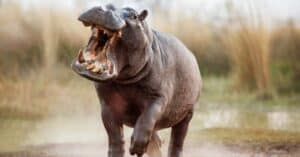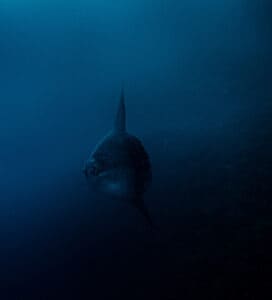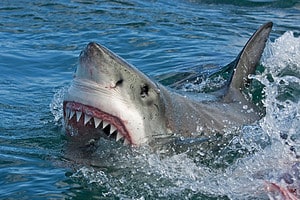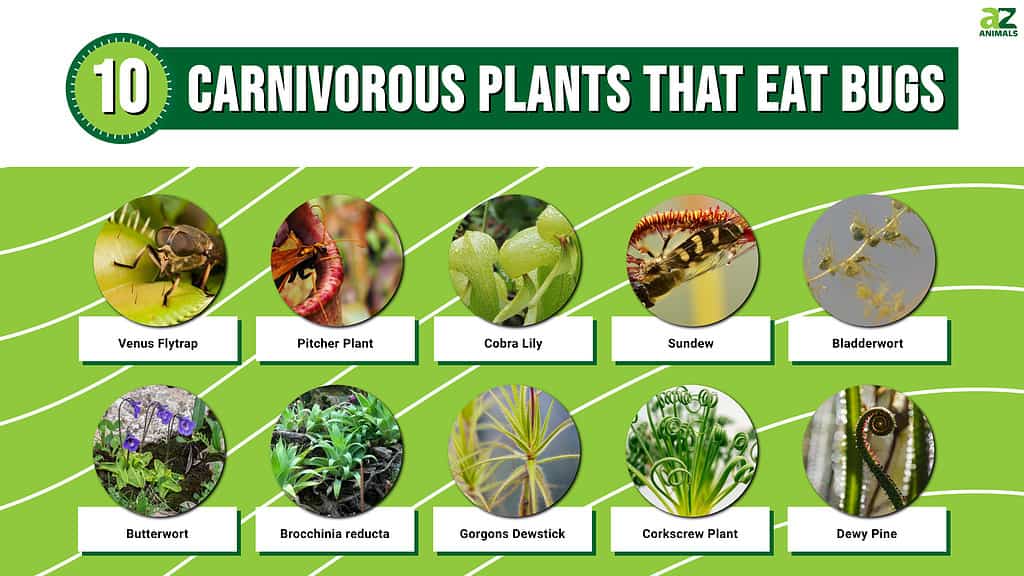
How Carnivorous Plants Work
When it comes to plants, we tend to think of them as purely feeding on water and nutrients in the soil. Plants that cannot get nourishment from the soil will readily absorb animal bones and even human flesh stuck in the ground, and garden centers have blood and bone meal fertilizers. But we never think of plants that are truly carnivorous and actively target small, living animals as their source of gas, chemical, and mineral nutrients using one or a combination of the following trapping mechanisms:
- Snapping: Quickly shutting closed around the animal.
- Flypaper: A glue-like, sticky substance that immobilizes the prey.
- Pitfall: A rolled leaf with a deadly pool of digestive bacteria or enzymes which drowns the prey before the plant eats it.
- Bladder: A bladder sucks in prey by generating an internal vacuum.
- Lobster or Eel: inward-pointing hairs force the prey to move towards the digestive organ.
Growing in thin and sparse soil of mostly heaths, bogs, and swamps, and usually, in temperate or tropical climates, carnivorous plants evolved to be deadly to their prey so as to access nutrients. These include macronutrients like protein, nitrogen, potassium, and phosphorus and micronutrients like sulfur, calcium, and magnesium.
It takes careful attention to successfully grow these species, which are not as easy to care for as you may think due to being susceptible to pests like greenflies and spider mites if experiencing poor air circulation and low humidity. On the other hand, they do not need fertilizer, non-natural water sources, or to be fed bugs but can instead catch them by themselves, especially outside. These ten plants need to eat meat to live and will shock you with their strange, pretty looks and even more so with their predatory survival methods.
Venus Flytrap
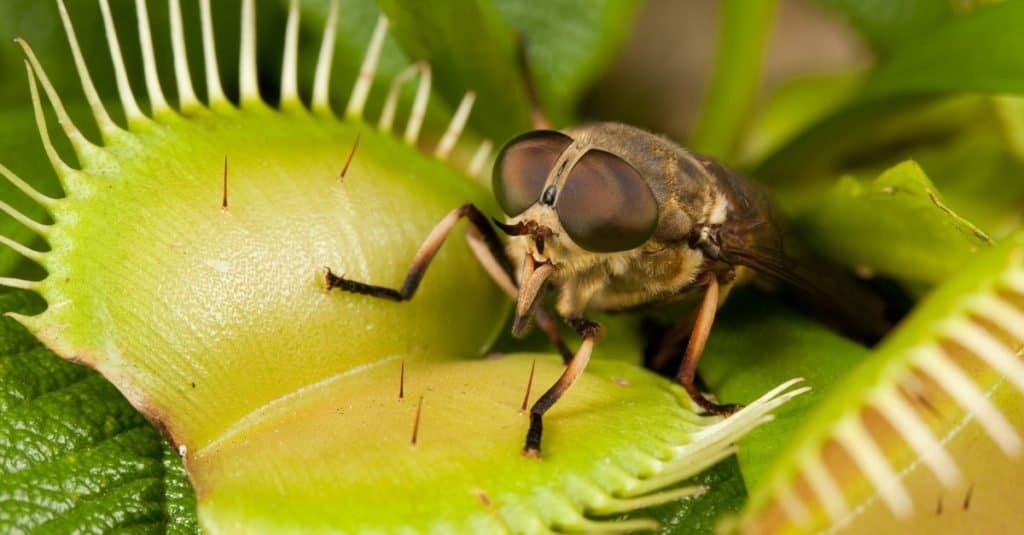
©Linas T/Shutterstock.com
The Venus flytrap is certainly the most well-known of carnivorous plants. It is also easiest to acquire, being inexpensive and small enough to likely find in your store’s floral department rather than having to visit your local nursery. True to its name, it uses the snapping trap to capture prey – after it lures them in with its sweet smell and fluorescent blue glow, that is.
And while its most common prey is indeed the fly, it also eats ants, beetles, other insects, and arachnids, even frogs. Once it snaps shut, it takes up to 10 days to consume the prey with red sap and open to reveal the exoskeleton. One caveat: You can’t feed it the same meat humans eat, so if you give it a hamburger, it will rot and die. However, frogs, lizards, and small birds are fine if you want to feed it something more substantial than its typical meal of small insects. Interestingly, the Waterwheel Plant is like the aquatic version of this plant in both genetics and trapping mechanism.
Scientific name: Dionaea muscipula
Habitat: Tropical wetlands of North Carolina and South Carolina
Species: 1
Pitcher Plant or Monkey Cup
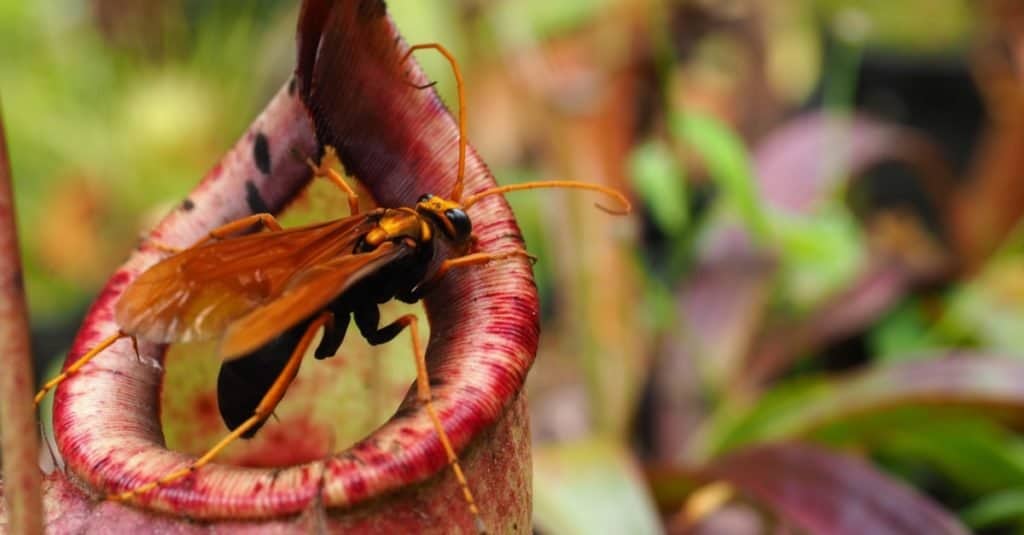
©JTKP/Shutterstock.com
There are many varieties of pitcher plants, the tropical versions of which are also called monkey cups, but which all have the same trapping mechanisms: A hybrid combination of lobster pot and pitfall. Their slippery insides and bristles ensure the prey’s very rare escape. Plus, most have sugars laced with an alkaloid to intoxicate the prey. They also all eat insects – even butterflies, grasshoppers, and crickets. The monkey cups may hold a liter of water and monkeys have been seen drinking from them. Thirsty humans can also drink from them.
Scientific name: Mainly the genera Nepenthes, Sarracenia, Heliamphora, and Cephalotus
Habitat: Sarracenia in the sandy bogs of the southeastern U.S. (the Carolinas, Virginia, Florida, Georgia, and Alabama); Nepenthes in the humid bogs of the Phillippines, Malaysia, Indonesia, Sumatra, Borneo, and Madagascar; Cephalotus in Australia.
Species: Nepenthes – 150; Sarracenia – 8 to 11; Heliamphora – 23; Cephalotus – 1
Cobra Lily or California Pitcher Plant
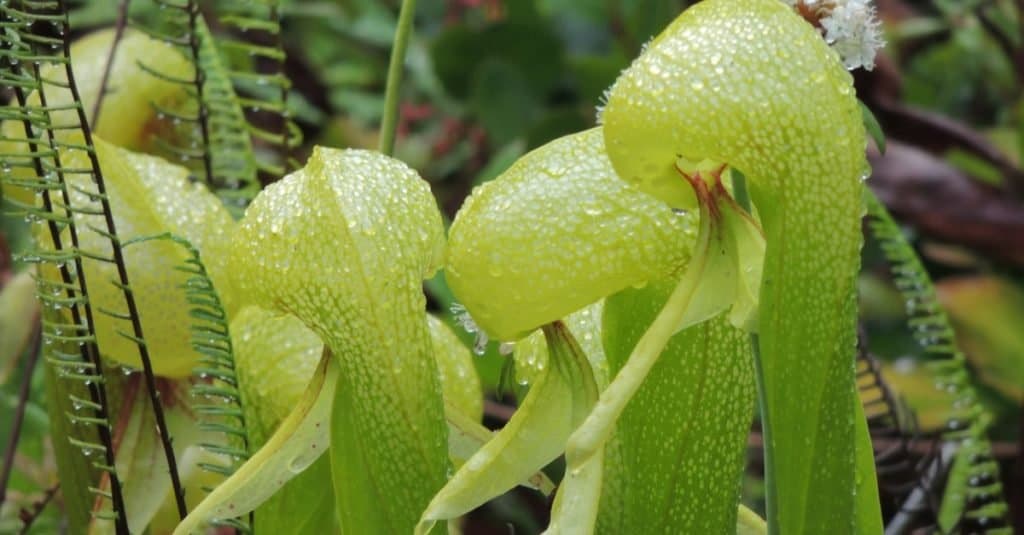
.
©Arty Alison/Shutterstock.com
Although the cobra lily is a type of pitcher plant, it doesn’t resemble the description of a monkey cup or even an obvious pitcher shape. Its appearance is markedly different. Instead, it looks like a cobra with its head curled up and ready to strike. Also unlike other pitcher plants, it doesn’t trap rainwater but instead fills up its pitcher with water it absorbs from its roots. However, it likewise eats a variety of insects from small to large and uses both lobster pot and pitfall trapping mechanisms. Its many false exits with transparent patches trap its prey which when it’s exhausted, succumbs to drowning in the liquid.
Scientific name: Darlingtonia californica
Habitat: Bogs in California and Oregon
Species: 1
Sundew
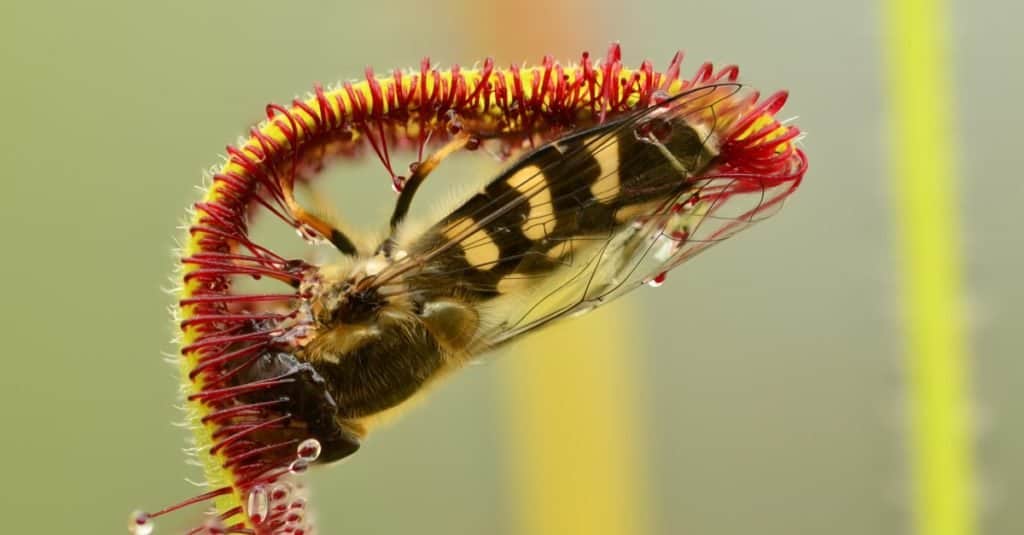
©Robert Evenflow/Shutterstock.com
Another carnivorous plant with several geographic varieties, the sundew uses both flypaper and snapping tentacles as trapping mechanisms to capture and eat insects. Like its name, it looks like the ends of the hairs on its leaves have the dewdrops that appear with the morning sun. These droplets are anything but water, though, so thirsty insects get stuck on the small but deadly plant.
Scientific name: Drosera (genus)
Habitat: Fens, bogs, and marshes everywhere except Antarctica
Species: 194
Bladderwort
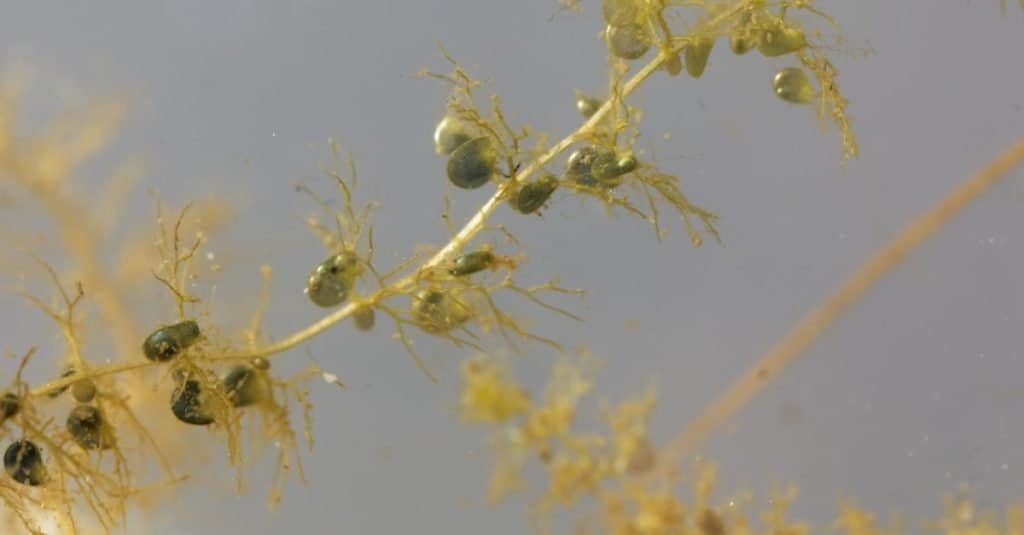
©ChWeiss/Shutterstock.com
The bladderwort most obviously uses the bladder trap to capture and eat insects, aquatic worms, water fleas, fish fry, mosquito larvae, and young tadpoles. But how exactly does it work? This aquatic plant pumps out water from its bladders to create vacuum suction. When prey comes and touches the bristles on the flexible openings, the bladder opens to take in the prey along with water.
Scientific name: Utricularia (genus)
Habitat: Freshwater streams, lakes, flooded areas, and wet soil in Europe and Asia
Species: 230
Butterwort or Sticky Leaf
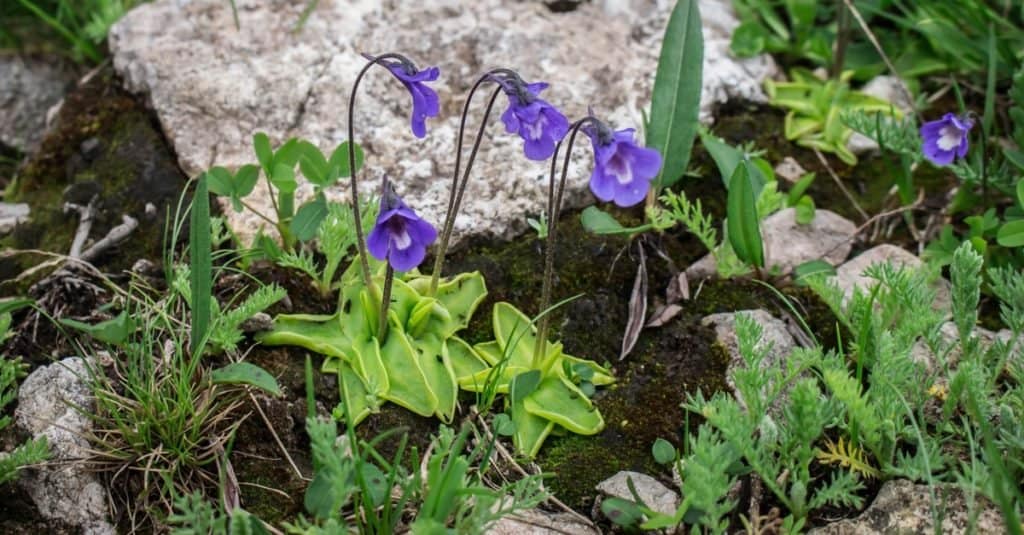
©IvanaStevanoski/Shutterstock.com
Bright, orchid-like flowers are the feature of this plant at first sight. Look closer, though, and you’ll see tiny hairs that secrete a mucus-like substance. The vivid colors of the flowers, whether white, pink, yellow, or purple, attract the prey, the flypaper traps it and then the leaves secrete digestive juices. It eats crickets, flies, spiders, caterpillars, slugs, gnats, springtails, and fruit flies.
Scientific name: Pinguicula (genus)
Habitat: North America, Central America, South America, and Eurasia
Species: 83
Brocchinia reducta
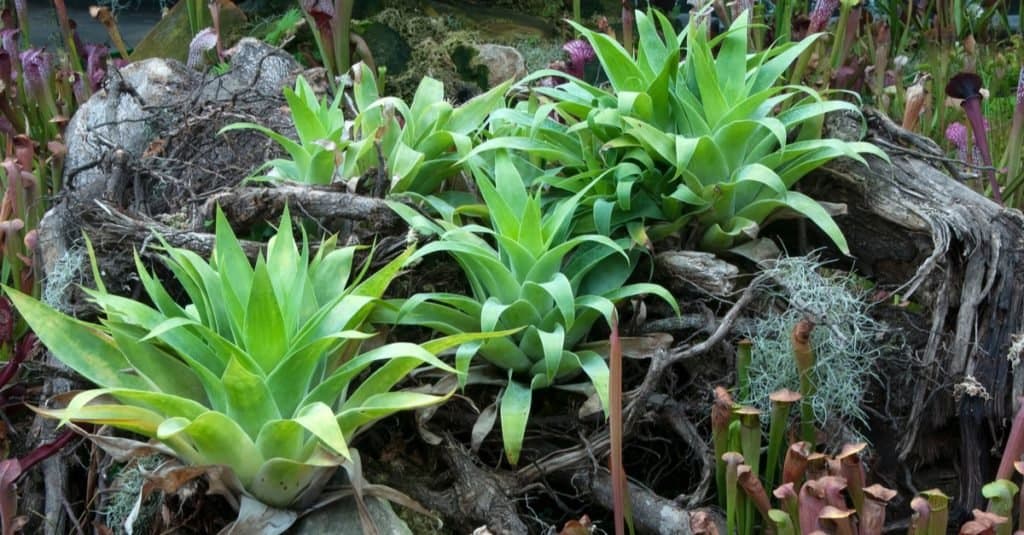
©demamiel62/Shutterstock.com
There is no common name for this carnivorous bromeliad, a plant belonging to the same family as pineapple, thick-leaved succulents, and Spanish mosses. Its trapping mechanism is the pitfall, aided by the reflection of ultraviolet light, a sweet scent, and it’s slippery, waxy surface which prevents claw anchorage. The flies and other insects then slide down towards their doom to be digested by enzymes.
Habitat: Guyana, Brazil, Colombia, Venezuela, Siberia, and North America
Species: 1
Fly Catcher Bush, or Gorgon’s Dewstick
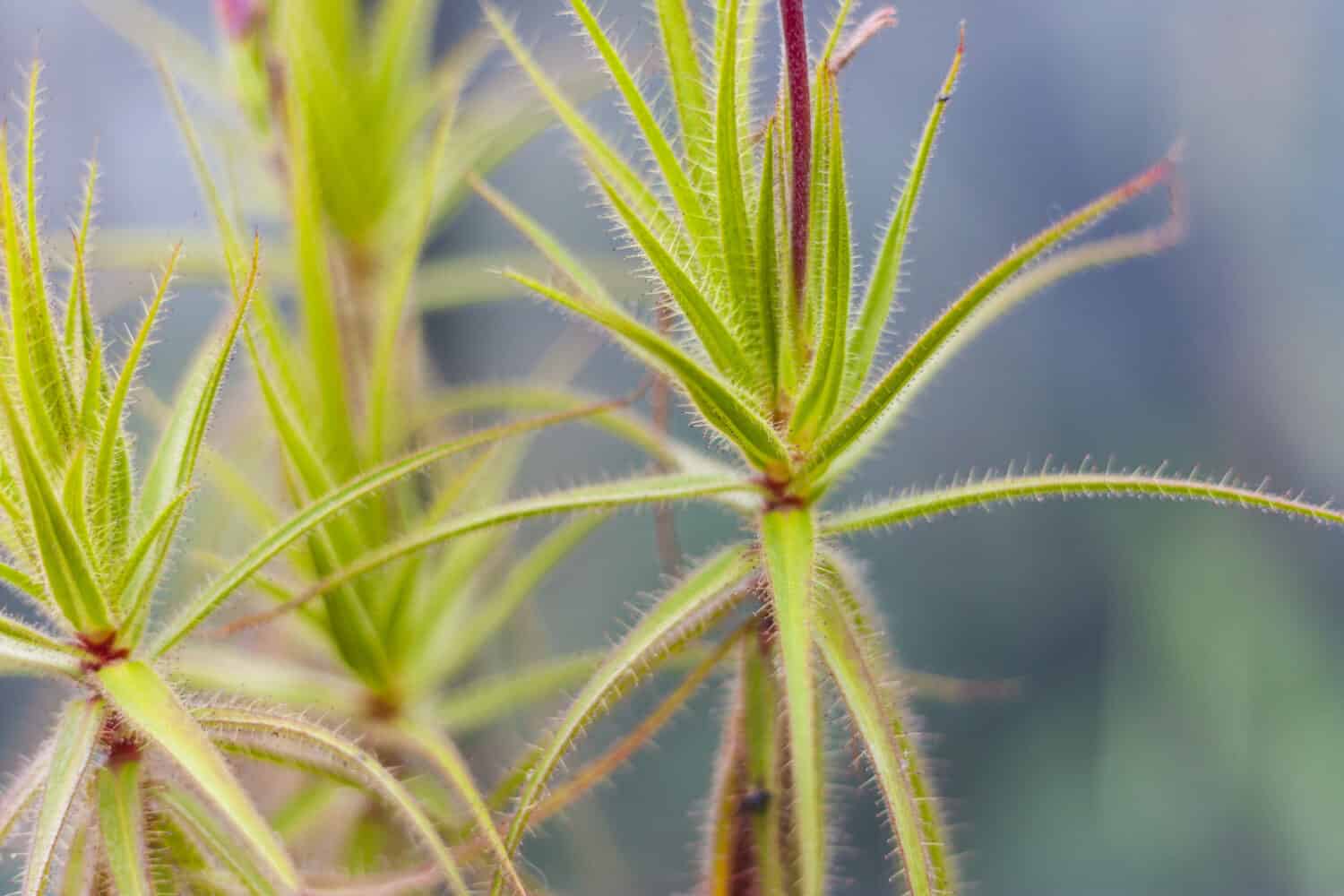
©kentaylordesign/Shutterstock.com
The flypaper mechanism is the trap that Gorgons Dewstick uses to capture wasps, bees, and other insects. The shiny resin on the tentacles attracts the prey, only for them to become stuck. This plant is recognizable for its flower spikes with white or pinkish-purple petals.
The plant doesn’t digest the insects on its own. Rather, it relies on another bug, Pameridea roridulae, to feed on the trapped prey so the plant can absorb nutrients from Pameridea roridulae‘s droppings.
Scientific name: Roridula gorgonias
Habitat: Cape Provinces of South Africa
Species: 1
Corkscrew Plant
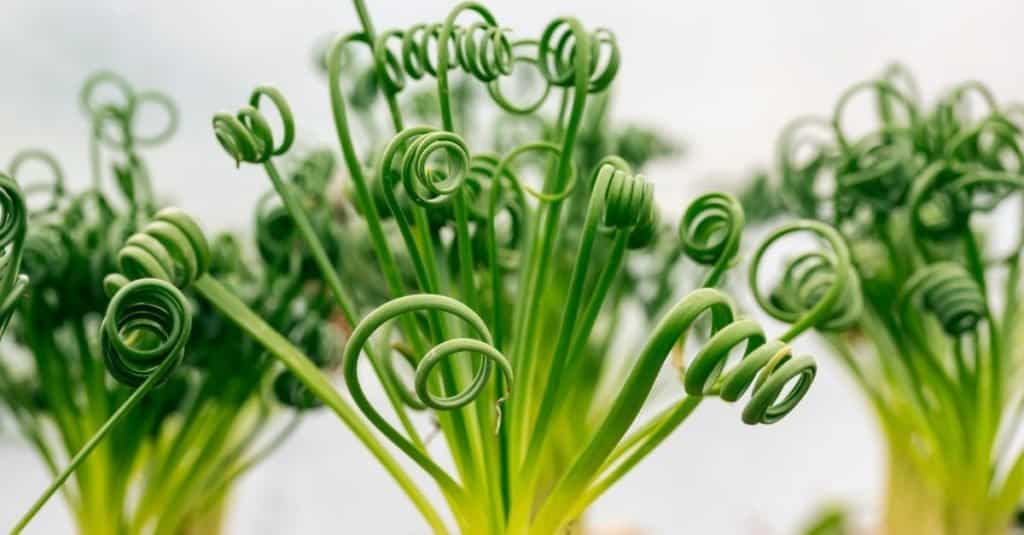
©Fabrizio Guarisco/Shutterstock.com
This carnivorous plant differs from other predatory photosynthetic life-forms in that it doesn’t target insects. Instead, it eats microscopic organisms, including protozoans using the lobster pot trap. Also, rather than attracting its prey above-ground, it has specialized leaves growing under the soil. It also has above-ground leaves which photosynthesize light, and it is classified as an herb.
Scientific name: Genlisea (genus)
Habitat: Semiaquatic regions of Central and South America as well as Tanzania, Madagascar, and Zambia in Africa
Species: 30
Dewy Pine
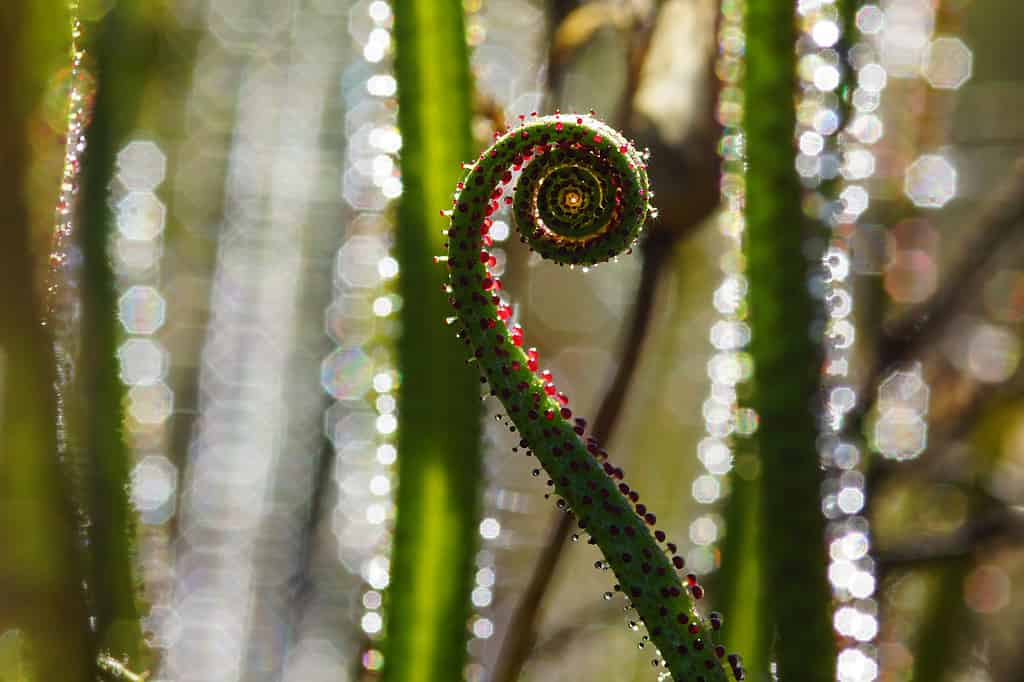
©anjahennern/Shutterstock.com
Unlike most other carnivorous plants, the dewy pine grows in dry areas. The dewy-looking secretions resemble honey to attract prey, while the sticky leaves trap it and an enzyme digests the insides of the insect to leave behind a dry shell.
Scientific name: Drosophyllum lusitanicum
Habitat: Dry regions of Morocco, Spain, and Portugal
Species: 1
Conclusion:
The over 700 species of carnivorous plants break the mold of what we traditionally believe plants to be. We tend to think of plants as completely passive, absorbing nutrients from the soil and generating energy through photosynthesis. But when nutrients in the soil, especially nitrogen, are scarce, what’s a plant to do? Trap and eat protozoans and arthropods, that’s what. While not dangerous to humans, they are deadly to small animals. Carnivorous plants display an ingenious method of adaptation to ensure their survival. They make for fascinating and challenging plant keeping, too.
Summary of 10 Carnivorous Plants That Eat Bugs
| Name of Plant | Trapping Type | Habitat |
|---|---|---|
| Dewy Pine | Flypaper | Dry regions of Morocco, Spain, and Portugal |
| Corkscrew Plant | Lobster pot | Semiaquatic regions of Central and South America, Tanzania, Madagascar, and Zambia |
| Gorgons Dewstick/Fly Catcher Bush | Flypaper | Cape Provinces of South Africa |
| Brocchinia reducta | Pitfall | Guyana, Brazil, Colombia, Venezuela, Siberia, and North America |
| Butterwort/Sticky Leaf | Flypaper | North, Central, and South America, and Eurasia |
| Bladderwort | Bladder | Freshwater streams, lakes, flooded areas, and wet soil in Europe and Asia |
| Sundew | Flypaper and snapping tentacles | Fens, bogs, and marshes everywhere except Antarctica |
| Cobra Lily/California Pitcher Plant | Lobster pot and pitfall | Bogs in California and Oregon |
| Pitcher Plant/Monkey Cup | Lobster pot and pitfall | Sandy bogs of the southeastern United States and humid bogs of the Philippines, Malaysia, Indonesia, Sumatra, Borneo, Madagascar, and Australia. |
| Venus Flytrap | Snapping | Tropical wetlands of North and South Carolina |
The photo featured at the top of this post is © Cathy Keifer/Shutterstock.com
Thank you for reading! Have some feedback for us? Contact the AZ Animals editorial team.




